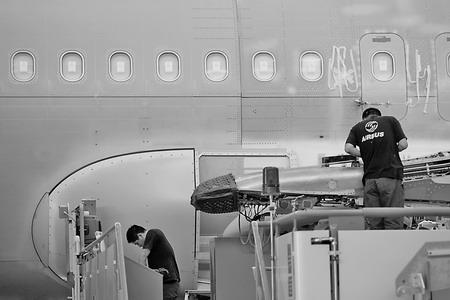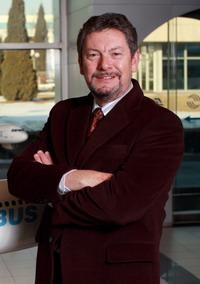
Technicians work on the final assembly line at Airbus SAS' A320 plant in Tianjin. The factory is now able to assemble three jets a month. [Photo / Bloomberg]
Airbus China president says Chinese business must be seen as two-way traffic
Laurence Barron, Airbus China president
BEIJING - Like many expatriates, Laurence Barron could make a long list of dislikes about Beijing - cold winter, traffic congestion and pollution - to name just a few.But the 60-year-old still loves living in Beijing and has decided to continue to keep a home in the capital city even after he retires.
"It just feels like this is the place to be right now in the world," said Barron, Airbus China president.
To Barron, the most irresistible temptation of living in the buzzing city comes from his work - grabbing half of the skies of China, the world's fastest growing commercial aviation market, before 2013.
The European aircraft manufacturer has steadily ramped up its fleet in China with its market share increasing from 7 percent in 1995 to 45 percent by the end of April. Its US rival, The Boeing Company, which had a 13-year head start in the country, still holds the rest of the market.
No one could afford to miss the China ride.
As the world's largest commercial aircraft market outside the United States, China saw its air traffic maintain an annual growth rate of 18 percent during the past three decades, which was three times the world's average growth rate of air transportation during the same period, according to figures from the Civil Aviation Administration of China (CAAC), the industry watchdog.
Looking ahead, China will be the biggest contributor of new air travelers by 2014, according to a report by the International Air Transport Association (IATA). China will not only see the world's fastest annual growth rate of international passenger traffic, at 10.8 percent, by 2014, but also record the highest annual growth rate of domestic passenger numbers, at 13.9 percent, during the period, said the Geneva-based organization that represents 230 airlines.
Size matters
While single-aisle aircraft, such as the Airbus 320 and the Boeing 737, have been the bread and butter for airplane manufacturers, with more of them being sold than any other types, Barron sees a rising demand for wide-bodied aircraft from China.
"For Asia, China in particular, size is going to be important," Barron said.
Continued congestion in hub airports is the major factor that drives up the size of aircraft, Barron said.
"With flight time slots at major airports becoming scarce, you can't always increase the number of flights. The only way is bigger aircraft. We would see the same trends in China," he added.
Another factor is the increasing comfort standards for flying.
"New business-class seats, with lie-flat beds, take up much more space than the old-fashioned S-shaped seats. That means fewer seats in the same floor area," Barron said.
Barron's remarks came after the Civil Aviation Administration of China (CAAC) recently sent out a clear message to encourage Chinese airlines to add more wide-bodied jets to their fleets and to explore the international market.
As high-speed trains eat into the lucrative domestic transport market, the increasing number of Chinese traveling overseas is providing fresh opportunities to Chinese airlines, which have been focusing their capacity on the domestic market, Li Jiaxiang, head of the CAAC, said at the China Civil Aviation Development Forum in May.
By the end of last year, of the 1,150 passenger aircraft fleet in China, only 146 are wide-bodied airliners with more than 250 seats, Li said.
Currently some 80 Airbus A330s are in service in China and there are around 40 on order. China has also ordered 10 A350s. The A350, due to enter into service in 2013, is Airbus' answer to the runaway success of Boeing's 787 Dreamliner.
New areas
The total transport turnover of the Chinese aviation industry is expected to grow at an annual rate of 13 percent during the 12th Five-Year Plan period (2011-2015), according to the CAAC. That rate is slightly lower than that in the previous five-year plan, during which the total transport turnover increased by 15.6 percent annually.
The "conservative" growth target for the coming five years is mainly a result of airspace restrictions and constraint on air traffic management facilities, CAAC officials said.
Currently only 23 percent of the airspace of the Chinese mainland is for civilian use, while in the US the percentage is more than 80 percent. Flight time slots at airports in Beijing, Shanghai and Guangzhou are scarce and Beijing Capital International Airport's flight time slots during peak hours have already become saturated. Last year 27.3 percent of flights in China were delayed or canceled due to air traffic control problems, up from 16.8 percent in 2005, CAAC figures show.
Improving the efficiency of airspace usage and air traffic control management by adopting modern technologies will be a key task during the 12th Five-Year Plan, the CAAC said.
That will provide a new opportunity for Airbus to increase its footprint in China, Barron said.
Meanwhile, China's plan to build 56 new airports during the 12th Five-Year Plan, while expanding existing ones, will provide huge opportunities for air traffic management systems and the development of modern navigation procedures. "Airbus will be active in traffic management and navigation procedures in China," Barron said.
Right place, right time

Born and educated in England, Barron spent 10 years working as an international commercial lawyer in Paris and Tokyo before joining Airbus SAS in 1982.
"If you start thinking about these big decisions (of moving) too much, you might frighten yourself off the idea. So I never analyzed too much," Barron said. So when Barron was asked to head Airbus' China operations in 2002, he was immediately interested in the offer even though he had never been to the country.
"At that time, the business in China was very difficult for Airbus. The dominant player was Boeing. To most people, it didn't appear to be an attractive place to come. But I didn't think too much," Barron recalled.
Barron arrived in China when Airbus aircraft only accounted for 23 percent of the Chinese fleet in service.
But Airbus' development in China picked up speed from 2004 when the European company concentrated on enhancing its industrial partnership with China. Its market share in the country nearly doubled over the past seven years. "It was a good instinct I think. I arrived at the right place at the right time," Barron said.
The Toulouse-based aircraft manufacturer realized it was not likely to achieve the target of grabbing half of the Chinese market unless it substantially increased its industrial footprint in the country, Barron recalled.
"It was a collective decision that we had to make a big effort in not only the commercial area, but also in the industrial arena. We need to substantially increase procurement from China and develop new ways we cooperate with the Chinese industry," he added.
"We can't just earn billions of dollars by selling aircraft to China and go home. It's got to be a two-way street."
Airbus purchased less than $20 million in aircraft components a year from China before 2004. Its subcontracting volume to China exceeded $200 million by the end of 2010 and is expected to reach $500 million a year in 2015. Six Chinese manufacturers, which are affiliated to China Aviation Industry Corp (AVIC), produce parts for Airbus aircraft. There are parts and components produced in China on all Airbus commercial aircraft types all the way from the A320 to the A380 double-deck superjumbo.
AVIC is also supplying components to Boeing and regional aircraft makers such as Embraer and a number of helicopter producers. About one third of Boeing's total fleets in service have components produced in China.
Airbus has built four joint ventures in the country, including an A320 final assembly line in Tianjin, a composite material manufacturing center in Harbin, Heilongjiang province, an engineering center in Beijing that designs parts for the A350 aircraft, and a pilot and engineer training center in Beijing.
"Airbus China is like a mini Toulouse now," Barron said.
The company's employment in China has also ballooned from fewer than 200 people in 2004 to more than 1,000 today, including those in the joint ventures.
"Laurence is the boss I have served the longest in my whole career," said Lindsey Mi, vice-president of communications at Airbus China. Before working at Airbus China, Mi had led Chinese communications functions for some of the world's biggest brands, including Dell Computer Corp and General Motors Co.
"Laurence always has his own clear judgment on projects and on people. He always gives full trust to his employees. I think that is the secret enabling him to successfully head such a big team in China," Mi said.
Barron likes Chinese food very much, with spicy fish cooked in Sichuan-style fermented bean sauce and chive dumplings being his favorite.
"I will split my time between Beijing and France after I retire," he said.





